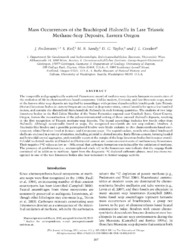Mass Occurrences of the Brachiopod Halorella in Late Triassic Methane-Seep Deposits, Eastern Oregon
Peckmann, J.
Kiel, S.
Sandy, M. R.
Taylor, D. G.
Goedert, J. L.
119, 2: 207 - 220
DOI: https://doi.org/10.1086/658199
Persistent URL: http://resolver.sub.uni-goettingen.de/purl?gldocs-11858/6948
Persistent URL: http://resolver.sub.uni-goettingen.de/purl?gldocs-11858/6948
Peckmann, J.; Kiel, S.; Sandy, M. R.; Taylor, D. G.; Goedert, J. L., 2011: Mass Occurrences of the Brachiopod Halorella in Late Triassic Methane-Seep Deposits, Eastern Oregon. In: The Journal of Geology, Band 119, 2: 207 - 220, DOI: 10.1086/658199.
 |
Dokument öffnen: |
The temporally and geographically scattered Phanerozoic record of methane-seep deposits hampers reconstruction of
the evolution of life in chemosynthesis-based ecosystems. Unlike modern, Cenozoic, and late Mesozoic seeps, many
of the known older seep deposits are typified by assemblages with profuse rhynchonellide brachiopods. Late Triassic
(Norian) limestone bodies in eastern Oregon are enclosed in deep-water strata, extend laterally for up to a few hundred
meters, and contain the dimerelloid rhynchonellide Halorella in rock-forming quantities. The analysis of two large
limestone bodies in the Rail Cabin Member of the Vester Formation exposed near Graylock Butte, Grant County,
Oregon, fosters the reconstruction of the paleoenvironmental setting of these unusual Halorella deposits, resulting
in the first recognition of Triassic methane-seep deposits. The faunal assemblage includes few fossils other than
Halorella. Although occasionally found at seeps, the recognized nuculanids are not seep-endemic bivalves. A
Nucinella-like bivalve and a possible permophorid bivalve were likely endemic to this chemosynthesis-based environment;
related bivalves lived at Jurassic and Cretaceous seeps. The superabundant, mostly articulated brachiopod
shells are enclosed in a variety of micrites, including peloidal to clotted micrite. Early fibrous cement, forming banded
and botryoidal crystal aggregates, preferentially occurs at the margin of the large limestone bodies but is scarce overall.
Peloidal to clotted micrite and banded and botryoidal cement are common constituents of methane-seep limestones.
Their negative d13C values as low as 36‰ reveal that carbonate formation was induced by the oxidation of methane.
The presence of pyrobitumen (i.e., metamorphosed crude oil) in the limestones may indicate that the seepage fluids
contained oil in addition to methane. Apart from the diagnostic 13C-depleted carbonate phases, mud injections recognized
in one of the two limestone bodies also bear testament to former seepage activity.

